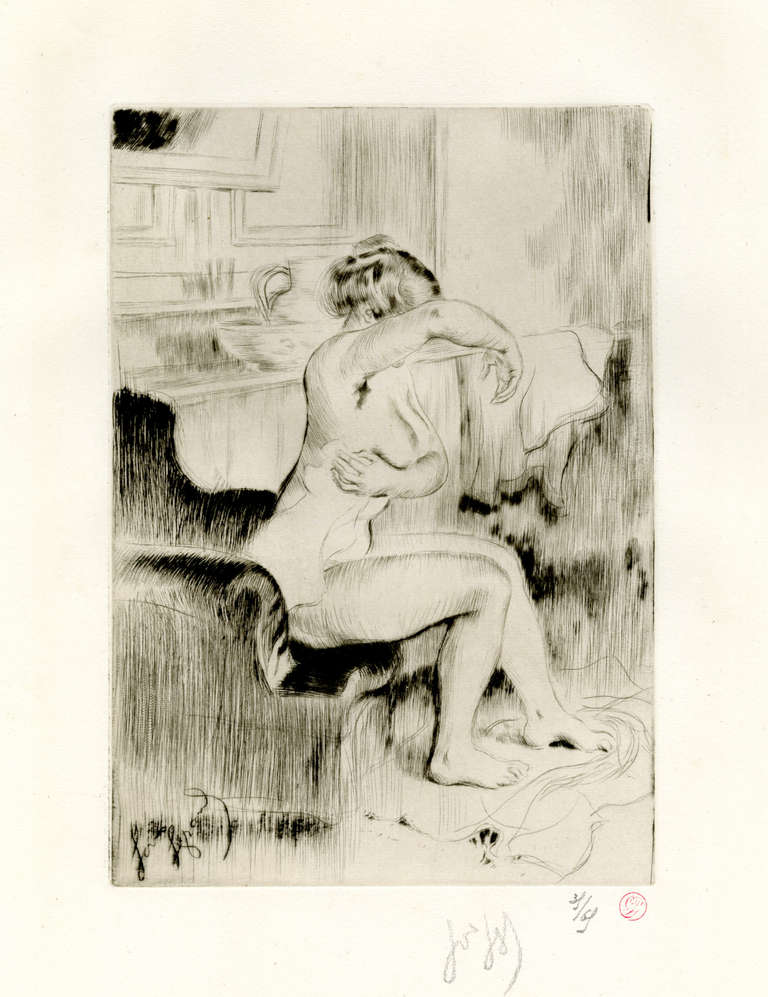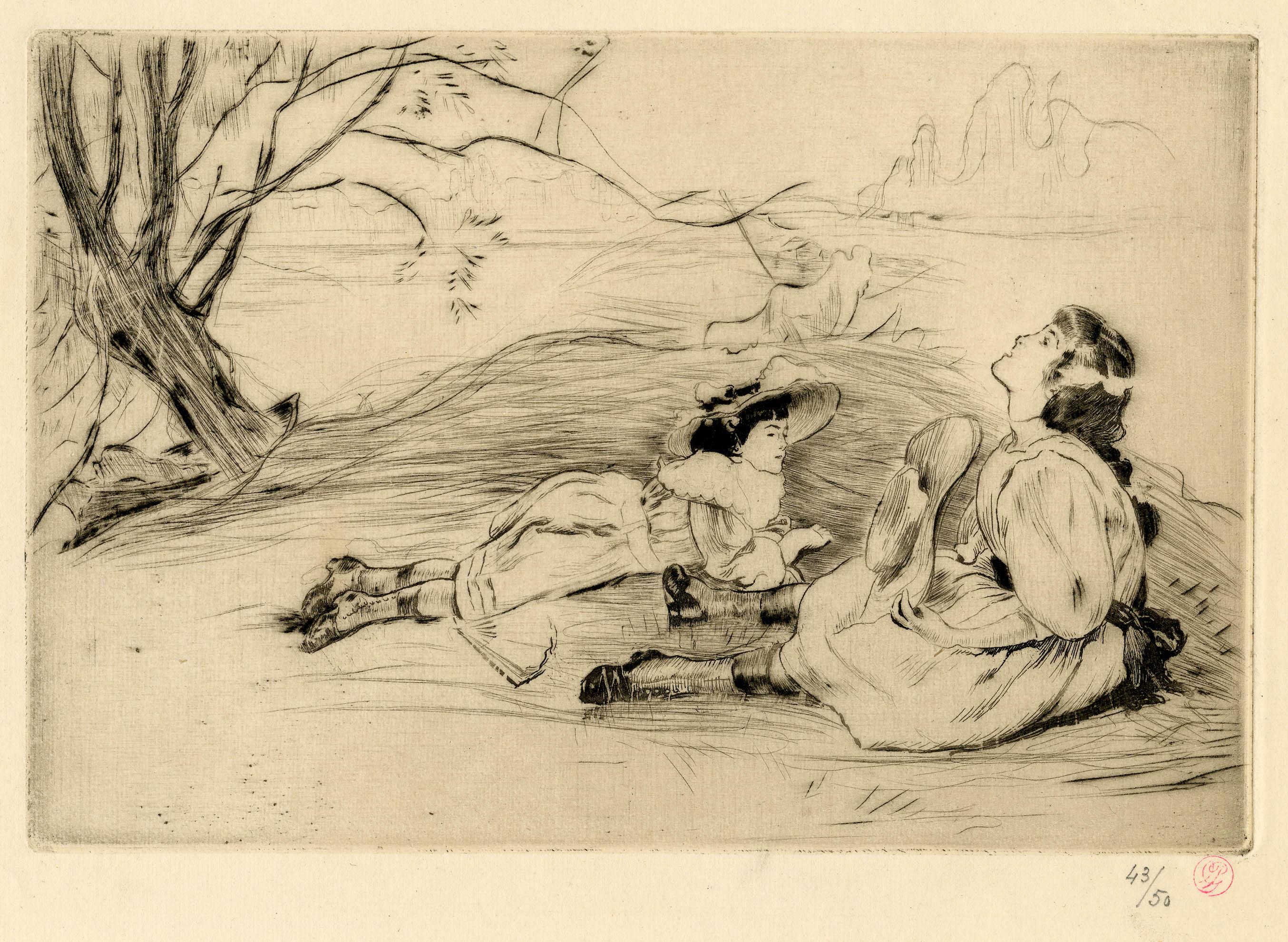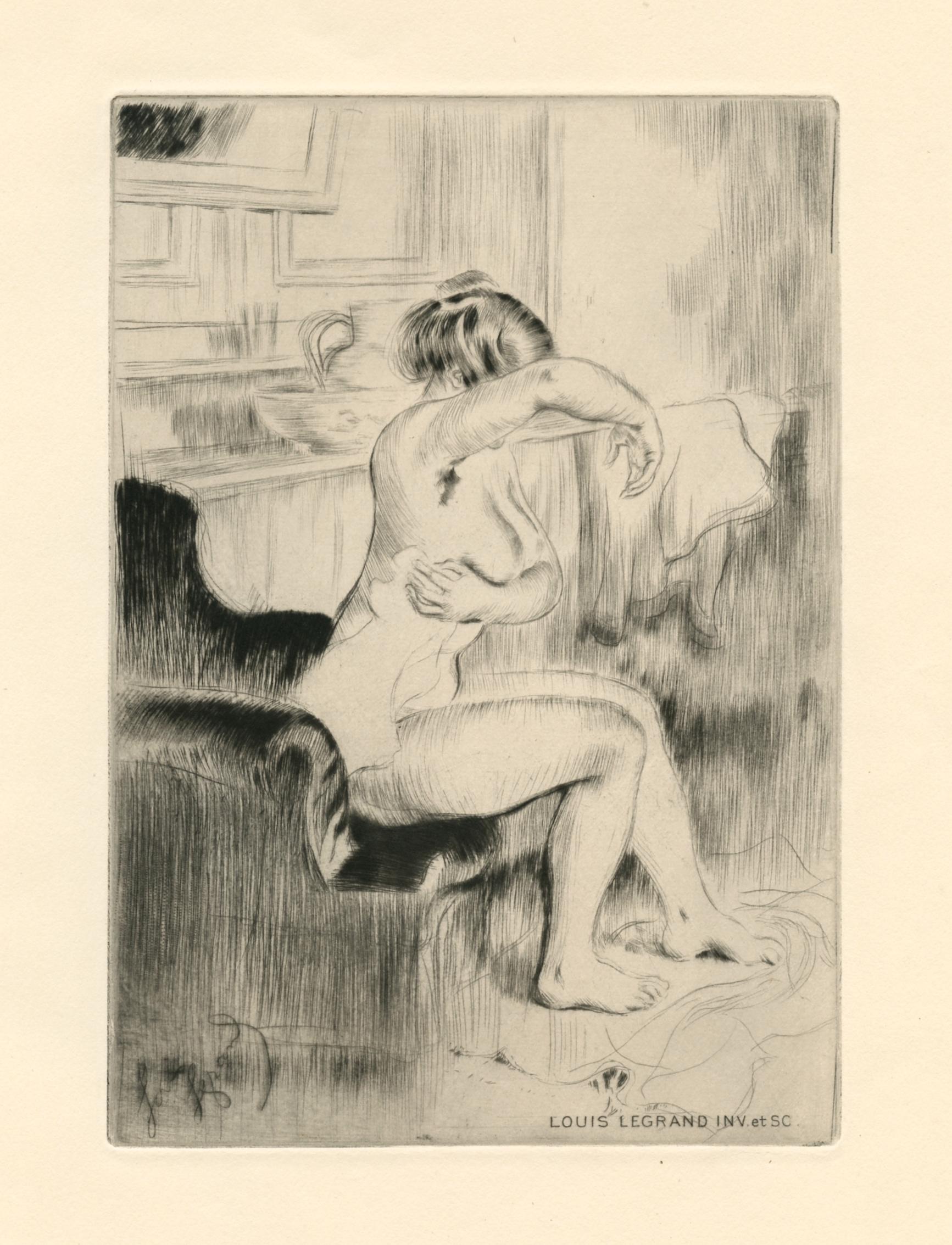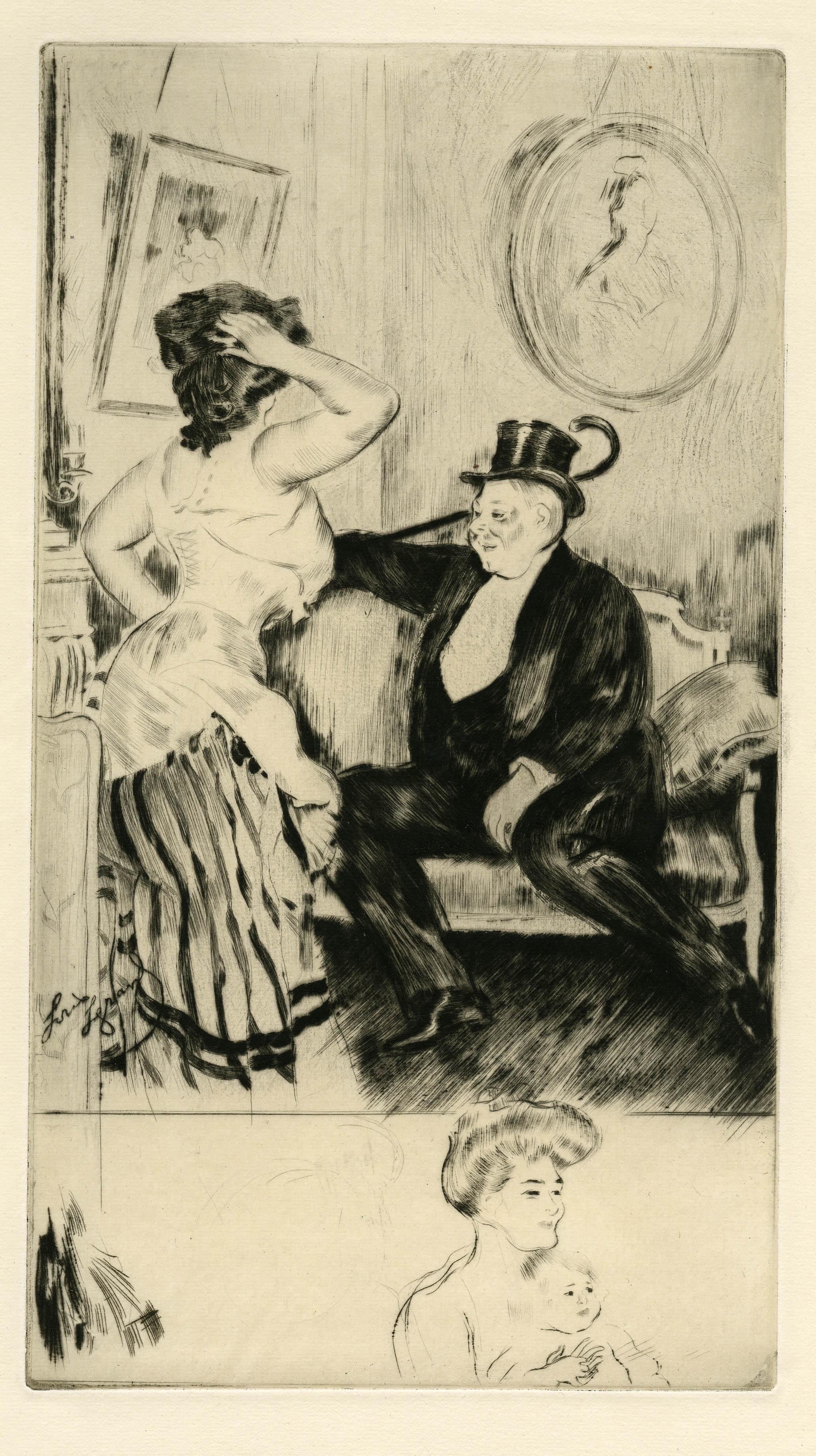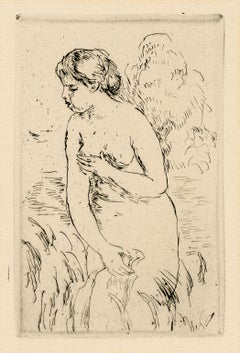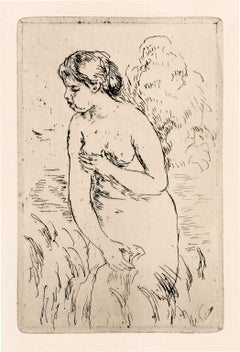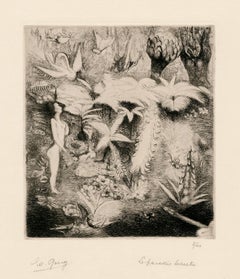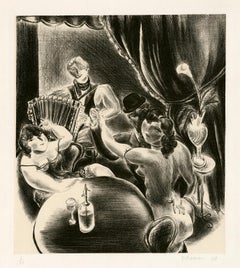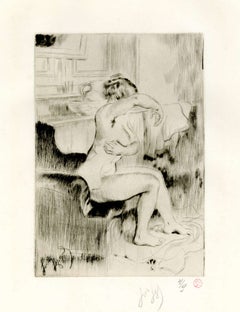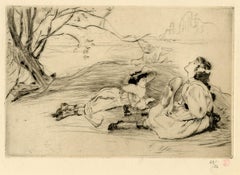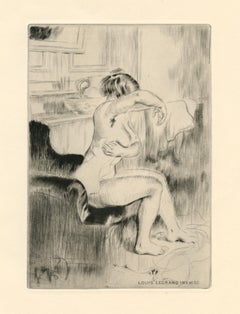Items Similar to 'The Serenade' — Fin-de-siècle French Romantic Eroticism
Want more images or videos?
Request additional images or videos from the seller
1 of 4
Louis Legrand'The Serenade' — Fin-de-siècle French Romantic Eroticismc. 1895
c. 1895
$960
$1,20020% Off
£738.50
£923.1220% Off
€857.18
€1,071.4820% Off
CA$1,353.83
CA$1,692.2920% Off
A$1,516.52
A$1,895.6520% Off
CHF 796.53
CHF 995.6620% Off
MX$18,440.35
MX$23,050.4420% Off
NOK 10,086.66
NOK 12,608.3320% Off
SEK 9,574.95
SEK 11,968.6920% Off
DKK 6,397.49
DKK 7,996.8720% Off
About the Item
Louis Legrand, 'The Serenade', soft-ground etching, drypoint, and aquatint, c. 1895, edition 20. Signed and numbered '9/20' in pencil. Annotated '20 proofs taken' in pencil, bottom left sheet edge. A superb, richly-inked impression, in dark sepia ink, with skillfully wiped plate tone and burr in the drypoint, on cream laid paper, with the Louis LeGrand watermark in the bottom center margin; the full sheet with wide margins (2 7/8 to 5 5/8 inches), in excellent condition. Very scarce.
An impression of this work is in the permanent collection of the Minneapolis Institute of Art.
ABOUT THE ARTIST
Louis Legrand (1863–1951) was a celebrated French artist best known for his evocative etchings and aquatints that captured the social life and undercurrents of fin-de-siècle Paris. Working in the tradition of satirical and socially observant printmakers such as Honoré Daumier and Félicien Rops, Legrand chronicled the urban scenes, cabarets, and demimondes of Montmartre with both sympathy and ironic detachment.
Born on September 29, 1863, in Dijon, France, Legrand initially worked as a bank clerk while studying art at the École des Beaux-Arts in Dijon. He later moved to Paris, where he studied under the caricaturist and etcher Felicien Rops, who became a major influence on his stylistic development. Legrand gained early experience as an illustrator for various periodicals, including *Gil Blas*, a popular Parisian journal known for its literary and artistic content.
Legrand's mature work emerged through the printmaking mediums of etching and aquatint, often employing soft-ground techniques to combine tonal richness with subtle line work. His prints frequently depicted scenes of dancers, bathers, prostitutes, and café patrons—subjects popularized by his contemporaries Edgar Degas and Henri de Toulouse-Lautrec. However, Legrand's works were often more introspective, balancing sensuality with social critique.
His celebrated print series, such as 'La Faune Parisienne' (1893), 'Les Petites du Ballet' (1893), 'La Femme' (1900), and 'L'Amour' (1908), documented the lives of working-class women and performers with both empathy and erotic candor. Legrand's combination of technical finesse and psychological insight earned him significant acclaim. He exhibited regularly at the Salon des Indépendants and the Salon d’Automne, and his prints were collected internationally.
In 1906, Legrand was awarded the Légion d’Honneur for his artistic contributions. Though he continued to paint and draw, it was his printmaking that secured his lasting reputation.
Louis Legrand died in Paris in 1951. Today, his works are held in major museum collections, including the British Museum, the Bibliothèque nationale de France, the Art Institute of Chicago, and the Metropolitan Museum of Art. He remains an important figure in the history of French graphic arts, admired for his ability to portray both the allure and melancholy of modern life with precision and poignancy.
- Creator:Louis Legrand (1863 - 1951, French)
- Creation Year:c. 1895
- Dimensions:Height: 8 in (20.32 cm)Width: 6.38 in (16.21 cm)
- Medium:
- Movement & Style:
- Period:
- Condition:
- Gallery Location:Myrtle Beach, SC
- Reference Number:Seller: 961971stDibs: LU53232609891
Louis Legrand
Louis Legrand was born in Dijon, France, on September 29, 1863. He worked as a bank teller and studied art at the Dijon Ecole des Beaux-Arts in his spare time. At the age of 20, he won the Devosge prize at that school and a year later left for Paris. Legrand arrived in Paris in 1884, where he studied under Felicien Rops and soon became famous for his paintings, drawings and etchings depicting the Parisian beau-monde. A superb draughtsman, his etchings also show great sophistication. Legrand's prints were almost all published by Gustave Pellet, who published many erotic images.
About the Seller
5.0
Recognized Seller
These prestigious sellers are industry leaders and represent the highest echelon for item quality and design.
Platinum Seller
Premium sellers with a 4.7+ rating and 24-hour response times
Established in 1995
1stDibs seller since 2016
311 sales on 1stDibs
Typical response time: 1 hour
Associations
International Fine Print Dealers Association
- ShippingRetrieving quote...Shipping from: Myrtle Beach, SC
- Return Policy
Authenticity Guarantee
In the unlikely event there’s an issue with an item’s authenticity, contact us within 1 year for a full refund. DetailsMoney-Back Guarantee
If your item is not as described, is damaged in transit, or does not arrive, contact us within 7 days for a full refund. Details24-Hour Cancellation
You have a 24-hour grace period in which to reconsider your purchase, with no questions asked.Vetted Professional Sellers
Our world-class sellers must adhere to strict standards for service and quality, maintaining the integrity of our listings.Price-Match Guarantee
If you find that a seller listed the same item for a lower price elsewhere, we’ll match it.Trusted Global Delivery
Our best-in-class carrier network provides specialized shipping options worldwide, including custom delivery.More From This Seller
View AllBaigneuse Debout, à Mi-Jambes — French Impressionism
By Pierre-Auguste Renoir
Located in Myrtle Beach, SC
Pierre Auguste Renoir, 'Baigneuse Debout, à Mi-Jambes (Woman Bathing, Standing Up to Her Knees in Water)', 1910, etching, edition not stated, Delteil 23. Unsigned as published. A fin...
Category
1910s Impressionist Nude Prints
Materials
Etching
'Baigneuse Debout, à Mi-Jambes' — French Impressionism
By Pierre-Auguste Renoir
Located in Myrtle Beach, SC
Pierre Auguste Renoir, 'Baigneuse Debout, à Mi-Jambes (Woman Bathing, Standing Up to Her Knees in Water)', 1910, etching, edition not stated, Delteil 23. Unsigned as published. A fin...
Category
1910s Impressionist Nude Prints
Materials
Etching
$600 Sale Price
20% Off
'Le Paradis Terrestre' (Paradise on Earth) — French Symbolism
By Edouard Goerg
Located in Myrtle Beach, SC
Edouard Goerg, 'Le Paradis Terrestre' (Paradise on Earth), etching, 1931, edition 40. Signed, titled, and numbered '3/40' in pencil. A fine richly-inked impression, on heavy, cream w...
Category
1930s Symbolist Figurative Prints
Materials
Etching
'Dancing' — 'les années folles' Paris Masterwork, 1928
By Yasuo Kuniyoshi
Located in Myrtle Beach, SC
Yasuo Kuniyoshi, 'Dancing', lithograph, 1928, edition 30, Davis L-29. Signed, dated, and numbered '8/30' in pencil. A superb, richly-inked impression, printed on cream chine appliqué on heavy off-white wove backing; the full sheet with wide margins (1 3/8 to 4 7/8 inches), in excellent condition. Printed by Desjobert, Paris. Scarce. Matted to museum standards, unframed.
Impressions of this work are in the collections of the Museum of Modern Art, Whitney Museum of Modern Art, and Yasuo Kuniyoshi Museum (Japan).
ABOUT THIS WORK
The French economy boomed from 1921 until the Great Depression reached Paris in 1931. This period called 'Les années folles' or the 'Crazy Years', saw Paris reestablished as a capital of art, music, literature, and cinema. Paris in the 1920s and 1930s was the home and meeting place of some of the world's most prominent painters, sculptors, composers, dancers, poets, and writers. For those in the arts, it was, as Ernest Hemingway described it, "A moveable feast". Paris was home to an exceptional number of galleries, art dealers, and a network of wealthy patrons who offered commissions and held salons.
Pablo Picasso, perhaps the most famous artist in Paris, shared renown with a remarkable group of others, including the Romanian sculptor Constantin Brâncuși, the Belgian René Magritte, the Italian Amedeo Modigliani, the Russian émigré Marc Chagall, the Catalan and Spanish artists Salvador Dalí, Joan Miró, Juan Gris, and the German surrealist...
Category
1920s American Modern Nude Prints
Materials
Lithograph
Rendez-Vous — Early 20th-Century Modernism
By Boris Lovet-Lorski
Located in Myrtle Beach, SC
Boris Lovet-Lorski, Untitled (Rendez-Vous), lithograph, edition 250, 1929. Signed in pencil. Signed in the stone, lower right. From a suite of 10 lithographs published by the artist ...
Category
1920s American Modern Nude Prints
Materials
Lithograph
Nude at Piano
By John Sloan
Located in Myrtle Beach, SC
John Sloan, 'Nude at Piano', 1933, etching, edition 100, (only 85 printed), Morse 265. Signed, titled and annotated '100 proofs' in pencil. Signed and dated in the plate, lower right...
Category
1930s Ashcan School Nude Prints
Materials
Etching
You May Also Like
La Toilette
By Louis Legrand
Located in Fairlawn, OH
La Toilette
Drypoint, 1908
Signed and numbered in pencil by the artist (see photos)
Edition: 65 this state (35/65)
Published by Gustave Pellet (1859-1919),...
Category
Early 1900s Art Nouveau Figurative Prints
Materials
Drypoint
A L'Ombre (In Shadow)
By Louis Legrand
Located in Fairlawn, OH
A L'Ombre (In Shadow)
Etching & drypoint, 1905
Signed with the red stamp of the publisher Pellet (see photo)
Edition: 50 on velin paper, signed and numbered
Publisher: Gustav Pellet, Paris (his red stamp lower right, recto; Lugt 1193)
Condition: Excellent
Image/Plate size: 5-7/8 x 8-5/8" (14.8 x 21.8 cm.)
Sheet size: 11 5/8 x 17 1/8"
Reference: IFF 119
Exteens 229
Arwas 256 v/V
Louis Auguste Mathieu Legrand (29 September 1863 – 1951) was a French artist, known especially for his aquatint engravings, which were sometimes erotic. He was awarded the Légion d'honneur for his work in 1906.
Life
Legrand was born in the city of Dijon in the east of France. He worked as a bank clerk before deciding to study art part-time at Dijon's Ecole des Beaux-Arts. He won the Devosge prize at the school in 1883.[2] In 1884 Legrand studied engraving under the Belgian printmaker Félicien Rops.
Legrand's artworks include etchings, graphic art and paintings. His paintings featured Parisian social life. Many were of prostitutes, dancers and bar scenes, which featured a sense of eroticism. According to the Hope Gallery, "Louis Legrand is simply one of France's finest early twentieth century masters of etching." His black and white etchings especially provide a sense of decadence; they have been compared to those of Henri de Toulouse-Lautrec, though his drawings of the Moulin Rouge, the can-can dance and the young women of Montmartre preceded Toulouse-Lautrec's paintings of similar scenes. He made over three hundred prints of the night life of Paris. They demonstrate "his remarkable powers of observation and are executed with great skill, delicacy, and an ironic sense of humor that pervades them all."
Two of his satirical artworks caused him to be tried for obscenity. The first, "Prostitution" was a symbolic drawing which depicted a naked girl being grasped by a dark monster which had the face of an old woman and claws on its hands; the second, "Naturalism", showed the French novelist Émile Zola minutely studying the thighs of a woman with a magnifying glass. Defended by his friend the lawyer Eugène Rodrigues-Henriques (1853–1928), he was found not guilty in the lower court, but was convicted in the appeal court and then given a short prison sentence for refusing to pay his fine.
Legrand was made famous by his colour illustrations for Gil Blas magazine's coverage of the can-can, with text by Rodrigues (who wrote under the pseudonym Erastene Ramiro). It was a tremendous success, with the exceptional quantity of 60,000 copies of the magazine being printed and instantly sold out in 1891.
In 1892, at the instigation of the publishing house Dentu, Legrand made a set of etchings of his Gil Blas illustrations. The etchings were published in a book, Le Cours de Danse Fin de Siecle (The End of the Century Dance Classes).
Legrand took a holiday in Brittany, which inspired him to engrave a set of fourteen lithographs of simple country life called Au Cap de la Chevre (On Goat Promontory). It was published by Gustave Pellet who became a close friend of Legrand's. Pellet eventually published a total of 300 etchings by Legrand, who was his first artist; he also published Toulouse-Lautrec and Félicien Rops among others.
He did not only work in graphics; he exhibited paintings at the Paris salon of the Société Nationale des Beaux-Arts starting in 1902. In 1906 he was made a chevalier of the Légion d'honneur.
Legrand died in obscurity in 1951. A retrospective exhibition was held at the Félicien Rops museum in Namur, Belgium in 2006 to celebrate his graphic art. The art collector Victor Arwas published a catalogue raisonné for the occasion.
Books illustrated
de Maupassant, Guy: Cinq Contes Parisiens, 1905.
Poe, Edgar Alan: Quinze Histoires d'Edgar Poe...
Category
Early 1900s Art Nouveau Landscape Prints
Materials
Etching
"La Toilette" original etching
By Louis Legrand
Located in Henderson, NV
Medium: original etching and drypoint. This impression on wove paper was printed in 1908 and published in Paris by the Revue de l'Art ancien et moderne. Plate size: 8 x 5 1/2 inches ...
Category
Early 1900s Nude Prints
Materials
Etching
L"Ame du Poete (The Soul of the Poet)
By Louis Legrand
Located in San Francisco, CA
This artwork titled "L'Ame du Poete (The Soul of the Poet)" 1901, is an original etching and aquatint by renown French artist Louis Auguste Mathieu Legrand, 1863-1951. Signed in the ...
Category
Early 20th Century Impressionist Figurative Prints
Materials
Etching, Aquatint
Delassement (Relaxation)
By Louis Legrand
Located in San Francisco, CA
This artwork titled "Delassement (Relaxation)" 1901, is an original etching and aquatint by renown French artist Louis Auguste Mathieu Legrand, 1863-1951. The plate mark (Image) size...
Category
Early 20th Century Impressionist Figurative Prints
Materials
Etching, Aquatint
En passant (Passing by)
By Louis Legrand
Located in Fairlawn, OH
En passant (Passing by)
Drypoint, 1909
Unsigned (as issued in the deluxe portfolio)
From the album "Les Bars" (8 plates plus cover illustration)
Edition: 30, this state with remarque
Published by Gustav Pellet, Paris
A very rich impression wwith burr
Condition: Excellent
Image/Plate size: 9 7/8 x 6 3/8 inches
Reference: Arwas 391a (remarque)
Exteens 277 i/II
IFF 148 (portfolio)
Louis Auguste Mathieu Legrand (29 September 1863 – 1951) was a French artist, known especially for his aquatint engravings, which were sometimes erotic. He was awarded the Légion d'honneur for his work in 1906.
Life
Legrand was born in the city of Dijon in the east of France. He worked as a bank clerk before deciding to study art part-time at Dijon's Ecole des Beaux-Arts. He won the Devosge prize at the school in 1883.[2] In 1884 Legrand studied engraving under the Belgian printmaker Félicien Rops.
Legrand's artworks include etchings, graphic art and paintings. His paintings featured Parisian social life. Many were of prostitutes, dancers and bar scenes, which featured a sense of eroticism. According to the Hope Gallery, "Louis Legrand is simply one of France's finest early twentieth century masters of etching." His black and white etchings especially provide a sense of decadence; they have been compared to those of Henri de Toulouse-Lautrec, though his drawings of the Moulin Rouge, the can-can dance and the young women of Montmartre preceded Toulouse-Lautrec's paintings of similar scenes. He made over three hundred prints of the night life of Paris. They demonstrate "his remarkable powers of observation and are executed with great skill, delicacy, and an ironic sense of humor that pervades them all."
Two of his satirical artworks caused him to be tried for obscenity. The first, "Prostitution" was a symbolic drawing which depicted a naked girl being grasped by a dark monster which had the face of an old woman and claws on its hands; the second, "Naturalism", showed the French novelist Émile Zola minutely studying the thighs of a woman with a magnifying glass. Defended by his friend the lawyer Eugène Rodrigues-Henriques (1853–1928), he was found not guilty in the lower court, but was convicted in the appeal court and then given a short prison sentence for refusing to pay his fine.
Legrand was made famous by his colour illustrations for Gil Blas magazine's coverage of the can-can, with text by Rodrigues (who wrote under the pseudonym Erastene Ramiro). It was a tremendous success, with the exceptional quantity of 60,000 copies of the magazine being printed and instantly sold out in 1891.
In 1892, at the instigation of the publishing house Dentu, Legrand made a set of etchings of his Gil Blas illustrations. The etchings were published in a book, Le Cours de Danse Fin de Siecle (The End of the Century Dance Classes).
Legrand took a holiday in Brittany, which inspired him to engrave a set of fourteen lithographs of simple country life called Au Cap de la Chevre (On Goat Promontory). It was published by Gustave Pellet who became a close friend of Legrand's. Pellet eventually published a total of 300 etchings by Legrand, who was his first artist; he also published Toulouse-Lautrec and Félicien Rops among others.
He did not only work in graphics; he exhibited paintings at the Paris salon of the Société Nationale des Beaux-Arts starting in 1902. In 1906 he was made a chevalier of the Légion d'honneur.
Legrand died in obscurity in 1951. A retrospective exhibition was held at the Félicien Rops museum in Namur, Belgium in 2006 to celebrate his graphic art. The art collector Victor Arwas published a catalogue raisonné for the occasion.
Books illustrated
de Maupassant, Guy: Cinq Contes Parisiens, 1905.
Poe, Edgar Alan: Quinze Histoires d'Edgar Poe...
Category
Early 1900s Art Nouveau Interior Prints
Materials
Drypoint
More Ways To Browse
Antique Finials
French Finial
Antique French Finial
Post Finial
Antique Sepia Prints
Le Faune
Charles Jordan
Keith Crown
Lady Hamilton
Munich Olympics 1972 Posters
Picasso Madoura Ceramic Pitcher
Stained Glass Christ
Vanity Fair Caricature
Venus Willendorf
Vintage Bikini Posters
Vintage Cuban Posters
Vintage Drug Posters
Vintage Fillmore Poster
